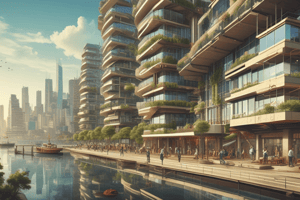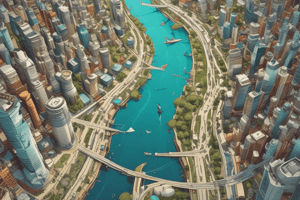Podcast
Questions and Answers
What is urban design?
What is urban design?
- A profession that deals with the construction of large buildings in urban areas.
- A movement that seeks to eliminate urbanization altogether.
- A field of study that focuses on the history of urbanization.
- An approach to the design of buildings and spaces that focuses on specific design processes and outcomes, considering economic, social, environmental, and social design issues. (correct)
What disciplines does urban design borrow knowledge from?
What disciplines does urban design borrow knowledge from?
- Architecture, engineering, and mathematics.
- Political science, economics, and history.
- Psychology, philosophy, and literature.
- Public administration, sociology, law, urban geography, urban economics, and other related disciplines from the social and behavioral sciences, as well as from the natural sciences. (correct)
What is the primary focus of urban design theory?
What is the primary focus of urban design theory?
- The construction of large buildings in urban areas.
- The design and management of public space and the way public places are used and experienced. (correct)
- The elimination of urbanization.
- The history of urbanization.
What is the concept of Expanding Nodular Development (E.N.D.)?
What is the concept of Expanding Nodular Development (E.N.D.)?
What is the key issue in urban design?
What is the key issue in urban design?
What is the issue of walkability?
What is the issue of walkability?
What is the approach of Everyday Urbanism?
What is the approach of Everyday Urbanism?
What was the issue with the design of towns and cities until the 1970s?
What was the issue with the design of towns and cities until the 1970s?
What is the goal of urban designers?
What is the goal of urban designers?
Flashcards
Urban Design
Urban Design
An approach to building and space design, integrating economic, social, and environmental factors.
Urban Design Theory
Urban Design Theory
The design and management of public spaces, reflecting social norms and beliefs.
Expanding Nodular Development (E.N.D.)
Expanding Nodular Development (E.N.D.)
A concept integrating urban designs and ecological principles for building smaller rural hubs connected by freeways.
Urban Design Theories
Urban Design Theories
Signup and view all the flashcards
Justice in Urban Design
Justice in Urban Design
Signup and view all the flashcards
Accessible Urban Design
Accessible Urban Design
Signup and view all the flashcards
Walkability
Walkability
Signup and view all the flashcards
Everyday Urbanism
Everyday Urbanism
Signup and view all the flashcards
Sustainable Urbanism
Sustainable Urbanism
Signup and view all the flashcards
Study Notes
Designing and Shaping of Human Settlements: A Summary
-
Urban design is an approach to the design of buildings and spaces that focuses on specific design processes and outcomes, considering economic, social, environmental, and social design issues.
-
Urban designers connect the fields of architecture, landscape architecture, and urban planning to better organize physical space and community environments.
-
Urban design is an interdisciplinary field that borrows knowledge from public administration, sociology, law, urban geography, urban economics, and other related disciplines from the social and behavioral sciences, as well as from the natural sciences.
-
Urban designers work to create inclusive cities that protect the commons, ensure equal access to public goods, and meet the needs of all residents, particularly women, people of color, and other marginalized populations.
-
Urban design theory deals primarily with the design and management of public space and the way public places are used and experienced.
-
Throughout history, the design of streets and deliberate configuration of public spaces with buildings have reflected contemporaneous social norms or philosophical and religious beliefs.
-
The beginnings of modern urban design in Europe are associated with the Renaissance, especially with the Age of Enlightenment.
-
In the 19th century, cities were industrializing and expanding at a tremendous rate, which created many hardships for the working poor and concern for public health increased.
-
In the early 1900s, urban planning became professionalized and new approaches to city design were developed for consideration by decision-makers such as elected officials.
-
In the 20th century, the automobile industry changed urban planning, and city layouts now revolved around roadways and traffic patterns.
-
Today, urban design seeks to create sustainable urban environments with long-lasting structures, buildings, and overall livability.
-
Managed Urbanisation with the view to making the urbanising process completely culturally and economically, and environmentally sustainable, and as a possible solution to the urban sprawl, Frank Reale has submitted an interesting concept of Expanding Nodular Development (E.N.D.) that integrates many urban designs and ecological principles, to design and build smaller rural hubs with high-grade connecting freeways, rather than adding more expensive infrastructure to existing big cities and the resulting congestion.Overview of Urban Design Theories and Issues
-
New Urbanism, Landscape Urbanism, Everyday Urbanism, Tactical Urbanism, Top-up Urbanism, Infrastructural Urbanism, Sustainable Urbanism, Feminist Urbanism, Educational Urbanism, and Black Urbanism are all different urban design theories.
-
Urban design discussions are centered around the efficacy of these approaches. Landscape Urbanism and New Urbanism are often debated as distinct approaches to addressing suburban sprawl. Everyday Urbanism argues for grassroots neighborhood improvements rather than master-planned, top-down interventions.
-
Urban designers work with architects, landscape architects, transportation engineers, urban planners, and industrial designers to reshape the city. Urban design holds enormous potential for helping us address today's biggest challenges: an expanding population, mass urbanization, rising inequality, and climate change.
-
Justice is a key issue in urban design. Urban designers must be careful not to overlook the nuances of race, place, and socioeconomic status in their design efforts. This includes ensuring reasonable access to basic services, transportation, and fighting against gentrification and the commodification of space for economic gain.
-
Until the 1970s, the design of towns and cities took little account of the needs of people with disabilities. The new profession of 'access officer' was established around that time to produce guidelines based on the recommendations of access groups and to oversee adaptations to existing buildings.
-
The issue of walkability has gained prominence in recent years, not only with the concerns of climate change, but also the health outcomes of residents. Car-centric urban design has an invariably negative effect on such outcomes. This issue has been used to fuel movements for alternative forms of transportation such as trains and bicycles, with walking as the primary means of short-range travel.
Studying That Suits You
Use AI to generate personalized quizzes and flashcards to suit your learning preferences.




